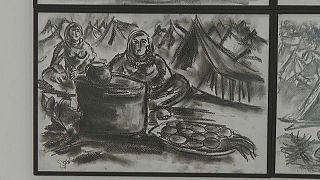Uganda
Deep in the Budongo Central Forest Reserve, a chimpanzee with an injured hand eats the leaves of a Christella parasitica fern.
The chimpanzee is not feeding because he is hungry according to researchers who've tracked the animals, but he's eating the fern because it has a potent anti-inflammatory effect.
Another female with a parasitic infection is seen eating the pith from Scutia myrtina, the bark of a cat-thorn tree, it's the first time chimpanzees from this community have been seen consuming this plant.
Tests at a laboratory reveal this bark contains both anti-inflammatory and antimicrobial properties.
A team from the University of Oxford closely tracked chimpanzees in two communities living in this forest.
The chimps eat a large variety of plants so it's not a simple task to understand whether this is because of hunger or because a plant has an impact on their health.
The Oxford team wanted to know if plants were being eaten passively or because they were medicinal.
The lead author, Elodie Freymann and her colleagues found that sometimes animals would leave their group and travel a distance to eat something which appeared to be nutritionally poor.
Earlier studies over the past two decades have shown animals are capable of self medicating.
A study by the Max Planck Institute on orangutans in May observed an animal chewing a plant and spitting the sap directly onto its wound.
Freymann says the team wanted to verify that the chimps they were studying were purposely seeking to medicate themselves.
She says: "Chimpanzees use leaves and different types of resources on their wounds to help promote you know wound healing. But a lot of the early research was on ingestion based behaviour. So plants and resources that chimpanzees consumed which had medicinal properties, either chemical properties or mechanical properties, which helped rid the chimpanzees of parasites. So what our study aimed to do was kind of expand the scope of the type of ingestion based behaviours that we looked at to not only look at resources that could help rid chimpanzees of parasite infections, but also potentially aid them in, fighting and combating bacterial infections and also, promote wound healing as well."
Freymann says the most difficult to identify were the chimpanzees who didn't have any obvious ailment.
"Sometimes you'll see chimpanzees sneezing and coughing, they'll have a runny nose, they'll be limping or they'll be you know, taking weight off of a certain limb that's injured. You can sometimes see an open wound. Other times it's more difficult to tell. So other times, chimpanzees might be suffering from a bacterial infection or some sort of internal ailment that is not necessarily obvious and in those cases, we needed to use a series of non invasive health monitoring methods to kind of figure out and triangulate what it was that they may have. So we collected samples in the field, urine and faecal samples, and we looked at, whether or not they were exhibiting sort of abnormal signs, if they had high parasite loads. And on cases when we had gathered that information and we saw that individuals did have, you know, signs of ill health or lowered immune systems, then we paid particular attention to what those chimpanzees were eating," she explains.
The team found the animals were specifically seeking out 13 species of plants, including dead wood.
They took these along with faecal and urine samples to collaborators in laboratories at the Neubrandenburg University of Applied Sciences in Germany.
The laboratory found that 88% of the plant extracts reduced bacterial growth, while 33% had anti-inflammatory properties.
Dead wood from a tree in the Dogbane family (Alstonia boonei) showed the strongest antibacterial activity and also had anti-inflammatory properties.
This plant and several others are also used in traditional human medicine.
"We also had this behavioural data to see what they were eating and any sort of unusual behaviours and together that evidence, kind of pointed us in the direction of 17 different plant parts from 13 different species of plants. We then collected those species, and we, we dried them out, and then we shipped them to a laboratory in Neubrandenburg, Germany, where our colleagues there, did a series of, extracts and then pharmacological assays on those samples. So we were looking particularly at the antibacterial effects of those plants and also the anti-inflammatory effects," says Freymann.
She says: "Many of these suspect resources that we saw the chimpanzees eating in unusual situations or when they were sick or injured, had quite strong bioactive properties. So they have in fact, medicinal properties and a number of these species were also found to be used ethnomedicinally in traditional human medicinal cultures as well."
What the scientists don't know yet is whether the animals know which plants to use instinctively, or whether it's learned behaviour from their mothers or other members of the chimpanzee community.
"For certain behaviours, there seem to be instinctual components, but for some behaviours, and I would say many of the behaviours we talk about in our study which are species specific so individuals seeking out certain plant parts at particular dosages of particular plant species. If I had to guess, I would say that I would think that these are socially learned behaviours, these are behaviours that individuals are learning from others in their community. And I would venture so far as to say that it might even be part of a medicinal culture. But more research has to be done," says Freymann.
In another part of Uganda, chimps at the Uganda Wildlife Conservation Education Centre at Entebbe have been observed doing similar things.
These animals won't be roaming in the wild like the Budongo chimps who are exposed to more vegetation but Dan Mirembe, head of the primate section says the staff keep track of the chimpanzee illnesses.
“The serious challenges that chimpanzees normally face are flu related infections, then as they get old, cardiovascular failures – they normally get problems with the heart that is when they get old."
Mirembe agrees many animals instinctively seek out medicinal plants and he says he's observed the animals here eat plants to induce themselves to push out parasites.
"So when the leaves get into the digestive system, they get entangled with the parasites so as they defecate the parasites come along with the leaves so that is the essence so, it is true that chimpanzees and the rest of the animals always do self-medication,” Mirembe explains.











01:50
The battle to save seagrass off Kenya's coast
01:42
World Rhino Day: Africa still needs to step up efforts to preserve the species
00:50
Kenya: Wildebeest migration draws scores of tourists
02:15
Hidden beehives help combat illegal logging along Kenya's coastline
00:58
Rescued Lion cub safe in South Africa, many others kept for hunting
02:01
South African researchers test use of nuclear technology to curb rhino poaching